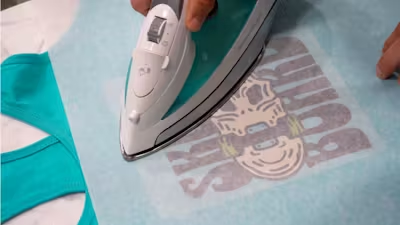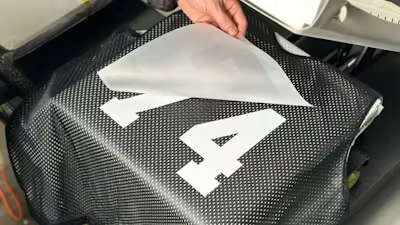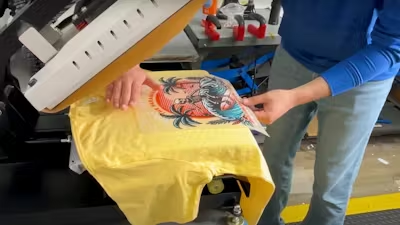Looking to maximize efficiency and quality in your DTF transfer process? The way you position garments on your heat press can make a significant difference. Whether you're starting a custom apparel business or planning a large shirt run, understanding when to load (also known as threading or sleeving) versus lay your garments is key to streamlining your workflow and ensuring consistent, professional results.
This article explains loading and laying, compares their benefits, and provides expert tips directly from our production team for achieving professional results with DTF transfers. We'll cover which method works best in most situations, when to make exceptions, and how to optimize your workflow for top-notch prints.

What is loading?
Loading, also known as threading or sleeving, is a method of positioning your garment on the heat press so that only a single layer of fabric rests on the surface and the rest of the garment wraps underneath the platen. With this technique, only the top layer of material receives direct heat and pressure when applying the DTF transfer, and it is particularly useful for certain types of garments or specific printing situations.
To load a garment, slide it onto the lower platen, typically from the bottom first, so that the collar (or top) is facing you. This keeps the front and back separate while the rest of the garment hangs freely below the platen.
Loading garments is required for other print methods, such as screen printing and DTG, but it's not necessarily needed for DTF printing. Although it can be more time-consuming than laying over the course of larger runs, it's often used for specific garment types or printing locations where isolating a single layer is beneficial.
What is laying?
Laying is a simpler method of positioning your garment on the heat press. With this technique, you simply place the entire garment flat on the lower platen, with both layers of fabric resting on the surface. This method is generally faster than loading, as it requires less manipulation of the garment. Both layers of the garment will be exposed to heat and pressure, but the DTF transfer is only applied to the top layer.
Laying is often preferred for its simplicity and speed, making it ideal for high-volume production. It also allows for easier alignment of the transfer, as the entire garment is visible and accessible on the platen. Refer to our DTF Transfer Placement Guide for detailed information on standard print placements.

What's best for DTF transfers?
In most cases, laying is the preferred method for applying DTF transfers. Here's why:
- Speed: Laying is significantly faster than loading, which can greatly boost your production efficiency. This time-saving aspect is crucial for high-volume orders or tight deadlines.
- Accuracy: Laying makes it easier to properly align your DTF transfer. When the entire garment is visible on the platen, you can ensure it's positioned straight and centered. Loading (threading or sleeving) can sometimes cause the shirt to go crooked or get slightly stretched, potentially resulting in a misaligned print.
- Consistency: With laying, you're more likely to achieve consistent results across multiple garments. The straightforward process reduces variables that could affect print placement.
- Ease of use: Laying is simpler, especially for beginners. It requires less manipulation of the garment, reducing the chance of errors.
While loading has its place in certain situations (which we'll cover next), laying is generally the go-to method for most DTF transfer applications. It offers a balance of speed, accuracy, and ease of use that makes it ideal for most custom apparel projects.

Exceptions: When to load
While laying is generally preferred, certain situations call for loading (threading or sleeving) your garments:
- Printing on jerseys: Mesh fabrics like those used in sports jerseys require special attention. Loading helps prevent the transfer from sticking to your heat press platen through the fabric's holes. For more details on handling jerseys, check out our full article about how to print jerseys with DTF transfers.
- Garments with obstructions: Items with buttons, zippers, pockets, or heavy seams can interfere with even heat distribution. For example, when printing on a quarter-zip pullover, polo shirt, or pocket hoodie, loading the garment ensures these elements don't affect the print area.
- Previously printed garments: If you're adding a design to a garment that already has a DTF print on the opposite side, loading is safer. While a second press usually doesn't cause issues, there's a small risk of the adhesive reactivating and the existing design shifting or sticking to the platen.
In these cases, loading helps isolate the print area and avoid potential complications. However, if you prefer laying, heat press pillows can sometimes be used as an alternative to loading, allowing you to work around obstructions while still laying the garment flat.

Pro tips for DTF transfer success
Whether you're loading or laying, these tips will help you achieve professional results:
- When loading (threading or sleeving) garments, secure your DTF transfer with Thermal Heat Tape. This ensures the design stays in place as you manipulate the garment. The tape peels off easily after pressing and can be reused.
- Use a Silicone Garment Protector to cover the upper platen. It provides more padding than a standard guard sheet. It's particularly useful when laying garments with slight obstructions, offering more forgiveness for buttons and seams. They are held in place with small magnets.
- Incorporate Heat Press Pillows will help you avoid loading when printing over zippers, pockets, or buttons. Insert the pillow between fabric layers to create an even pressing surface. Remember to adjust your pressure settings slightly when using pillows.
- Ensure precise placement with an Alignment Ruler Set for consistent, professional results across multiple prints. These clear ruler sets are designed for garments and work well whether you're laying or loading your items.
- Always do a test print when working with new garment types or designs. This allows you to fine-tune your settings and technique before committing to a full production run. Learn expert tips for DTF application and pressing at Ninja University.

Pressing ahead: Optimizing your DTF transfer workflow
Mastering the art of applying DTF transfers is key to producing high-quality custom apparel. While laying is generally the faster and more efficient method, loading (also known as threading or sleeving) has its place in specific situations. By understanding when to use each technique, you'll be well-equipped to handle a variety of garments and design challenges.
Remember, the goal is to achieve consistent, professional results while maximizing your productivity. Experiment with both methods to find what works best for your specific needs and workflow. Don't hesitate to invest in quality supplies like heat press pillows, protective guard sheets, and thermal heat tape to elevate your game.
At Ninja Transfers, we're committed to your success. We offer top-notch DTF transfers and all the supplies you need to apply them flawlessly. Plus, you can source premium blank apparel through our sister company, Ninja Blanks. We're always here to ensure your DTF transfer journey is smooth and successful.

































